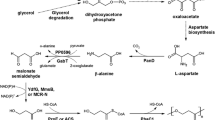Abstract
To efficiently produce polyhydroxyalkanoates (PHAs) from substrate mixture containing various carbon sources, Escherichia coli phosphotransferase system (PTS) mutants were constructed, in which the carbon catabolite repression in the presence of glucose was released. When cultivated in the medium containing glucose and xylose, E. coli LR1010, harboring phaC Re and phaAB Re genes from Ralstronia eutropha, could simultaneously consume glucose and xylose and accumulate short-chain-length PHA, whereas E. coli LR1120 and LR1110, harboring phaC1 gene from Pseudomonas aeruginosa, could accumulate medium-chain-length PHA. At the same time, LR1110 could simultaneously utilize the mixture of glucose and fatty acids. Semiquantitative reverse transcription polymerase chain reaction analysis indicated that disrupting phosphoenolpyruvate: sugar PTS in this strain released the repression on fad genes.




Similar content being viewed by others
References
Aldor IS, Keasling JD (2003) Process design for microbial plastic factories: metabolic engineering of polyhydroxyalkanoates. Curr Opin Biotechnol 14:475–483
Bruckner R, Titgemeyer F (2002) Carbon catabolite repression in bacteria: choice of the carbon source and autoregulatory limitation of sugar utilization. FEMS Microbiol Lett 209:141–148
Datsenko KA, Wanner BL (2000) One-step inactivation of chromosomal genes in Escherichia coli K-12 using PCR products. Proc Natl Acad Sci USA 97:6640–6645
DiRusso CC, Metzger AK, Heimert TL (1993) Regulation of transcription of genes required for fatty acid transport and unsaturated fatty acid biosynthesis in Escherichia coli by FadR. Mol Microbiol 7:311–322
Gosset G (2005) Improvement of Escherichia coli production strains by modification of the phosphoenolpyruvate: sugar phosphotransferase system. Microb Cell Fact 4:14
Huang TY, Duan KJ, Huang SY, Chen CW (2006) Production of polyhydroxyalkanoates from inexpensive extruded rice bran and starch by Haloferax mediterranei. J Ind Microbiol Biotechnol 33:701–706
Jenkins LS, Nunn WD (1987) Genetic and molecular characterization of the genes involved in short-chain fatty acid degradation in Escherichia coli: the ato system. J Bacteriol 169:42–52
Keenan TM, Nakas JP, Tanenbaum SW (2006) Polyhydroxyalkanoate copolymers from forest biomass. J Ind Microbiol Biotech 33:616–626
Lane DJ (1991) 16S/23S rRNA sequencing. In: Stackebrandt E, Goodfellow M (eds) Nucleic acid techniques in bacterial systematics. Wiley, Chichester, United Kingdom, pp 115–175
Langenbach S, Rehm BH, Steinbuchel A (1997) Functional expression of the PHA synthase gene phaC1 from Pseudomonas aeruginosa in Escherichia coli results in poly(3-hydroxyalkanoate) synthesis. FEMS Microbiol Lett 150:303–309
Lee SY (1996) High cell-density culture of Escherichia coli. Trends Biotechnol 14:98–105
Lee SY (1998) Poly(3-hydroxybutyrate) production from xylose by recombinant Escherichia coli. Bioprocess Eng 18:397–399
Li R, Zhang H, Qi Q (2007) The production of polyhydroxyalkanoates in recombinant Escherichia coli. Bioresour Technol (in press)
Pauli G, Ehring R, Overath P (1974) Fatty acid degradation in Escherichia coli: requirement of cyclic adenosine monophosphate and cyclic adenosine monophosphate receptor protein for enzyme synthesis. J Bacteriol 117:1178–1183
Qi Q, Rehm BH, Steinbuchel A (1997) Synthesis of poly(3-hydroxyalkanoates) in Escherichia coli expressing the PHA synthase gene phaC2 from Pseudomonas aeruginosa: comparison of PhaC1 and PhaC2. FEMS Microbiol Lett 157:155–162
Qi Q, Steinbuchel A, Rehm BH (1998) Metabolic routing towards polyhydroxyalkanoic acid synthesis in recombinant Escherichia coli (fadR): inhibition of fatty acid beta-oxidation by acrylic acid. FEMS Microbiol Lett 167:89–94
Ren Q, Sierro N, Witholt B, Kessler B (2000) FabG, an NADPH-dependent 3-ketoacyl reductase of Pseudomonas aeruginosa, provides precursors for medium-chain-length poly-3-hydroxyalkanoate biosynthesis in Escherichia coli. J Bacteriol 182:2978–2981
Schubert P, Steinbuchel A, Schlegel HG (1988) Cloning of the Alcaligenes eutrophus genes for synthesis of poly-beta-hydroxybutyric acid (PHB) and synthesis of PHB in Escherichia coli. J Bacteriol 170:5837–5847
Senn H, Lendenmann U, Snozzi M, Hamer G, Egli T (1994) The growth of Escherichia coli in glucose-limited chemostat cultures: a re-examination of the kinetics. Biochim Biophys Acta 1201:424–436
Shiloach J, Fass R (2005) Growing E. coli to high cell density—a historical perspective on method development. Biotechnol Adv 23:345–357
Solaiman DK, Ashby RD, Foglia TA, Marmer WN (2006a) Conversion of agricultural feedstock and coproducts into poly(hydroxyalkanoates). Appl Microbiol Biotechnol 71:783–789
Solaiman DK, Ashby RD, Foglia TA, Marmer WN (2006b) Conversion of agricultural feedstock and coproducts into poly(hydroxyalkanoates). Appl Microbiol Biotechnol
Spiekermann P, Rehm BH, Kalscheuer R, Baumeister D, Steinbuchel A (1999) A sensitive, viable-colony staining method using Nile red for direct screening of bacteria that accumulate polyhydroxyalkanoic acids and other lipid storage compounds. Arch Microbiol 171:73–80
Steinbuchel A, Lutke-Eversloh T (2003) Metabolic engineering and pathway construction for biotechnical production of relavent polyhydroxyalkanotes in microoganisms. Biochem Eng J 15:81–96
Stubbe J, Tian J, He A, Sinskey AJ, Lawrence AG, Liu P (2005) Nontemplate-dependent polymerization processes: polyhydroxyalkanoate synthases as a paradigm. Annu Rev Biochem 74:433–480
Stulke J, Hillen W (1999) Carbon catabolite repression in bacteria. Curr Opin Microbiol 2:195–201
Timm A, Byrom D, Steinbuechel A (1990) Formation of blends of various poly-3 hydroxyalkanoic acids by a recombinant strain of pseudomonas–oleovorans. Appl Microbiol Biotechnol 33:296–301
Wong HH, Lee SY (1998) Poly-(3-hydroxybutyrate) production from whey by high-density cultivation of recombinant Escherichia coli. Appl Microbiol Biotechnol 50:30–33
Zaldivar J, Nielsen J, Olsson L (2001) Fuel ethanol production from lignocellulose: a challenge for metabolic engineering and process integration. Appl Microbiol Biotechnol 56:17–34
Acknowledgement
This work was supported by a grant from the Ministry of Science and Technology of China (National Basic Research Program of China, 2007CB707803). We appreciate the plasmids provided by Dr. Wanner and the CGSC, the Coli Genetic Stock Center, Yale University.
Author information
Authors and Affiliations
Corresponding author
Rights and permissions
About this article
Cite this article
Li, R., Chen, Q., Wang, P.G. et al. A novel-designed Escherichia coli for the production of various polyhydroxyalkanoates from inexpensive substrate mixture. Appl Microbiol Biotechnol 75, 1103–1109 (2007). https://doi.org/10.1007/s00253-007-0903-2
Received:
Revised:
Accepted:
Published:
Issue Date:
DOI: https://doi.org/10.1007/s00253-007-0903-2



